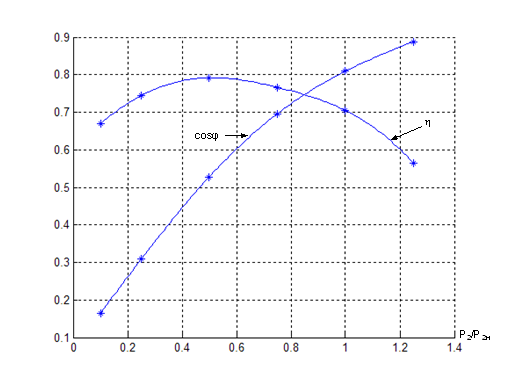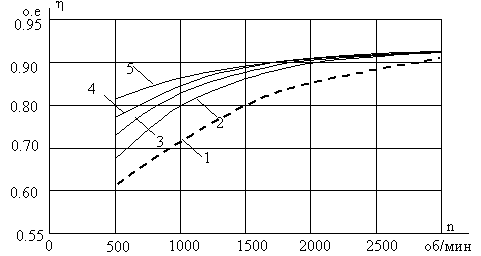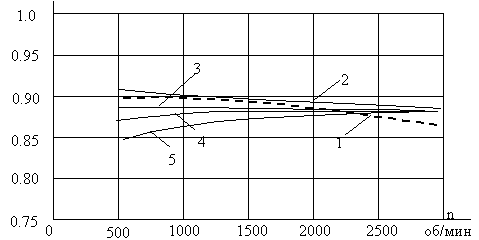Abstract
Contents
- Introduction
- 1. Relevance of the topic
- 2. Task of the research
- 3. Review of literature
- 4. Research methods, expected results
- References
Introduction
Development of technique is entailed by the considerable increase of consumable energy. From this number near 60 % consumed energy is on an electric drive. An electric drive is the most power-hungry consumer of electric power, qualificatory economic efficiency of productive processes and rates of increase of the labour productivity. A main technique–economic progress of electric drive trend 2000 to is expansion of application of electric drive of alternating current domains. Absence of collector, inherent to the engines direct-current, lifts restrictions on power of drive and allows to promote his shifting ability [7]. Developments of the managed electric drive of practically unlimited power became the real. The orders are already performed on such electric drive by power to 100 МW.
Mastering of production of power transistors provided possibility of creation of high-dynamic managed electric drive for a machine-tool construction and robotics. In the world, producing of asynchronous engines of different powers makes a few million things in a year.
1. Relevance of the topic
Presently inductive motors consume 40 % produced electric power more. The considerable proportion of this size is made by electric power consumed by inductive motors (pic. 1) in dynamic and set office hours [3]. It is related to continuous gain in specific weight of the dynamic modes in connection with intensification of productive processes and broadening introduction of the managed inductive drive on the base of frequency converter and microprocessor technique.

Picture 1 – Inductive motor
Most asynchronous electric motors are used either with the considerable underloading or at her substantial change. It conduces to the substantial decline of energy daums of engine. Therefore determination and clarification of calculation of energy daums of inductive motors are an important and actual task.
Presently for the calculation of losses of power and reactive watts-in in project practice use methods, being based on the operating data got by means of meters of active and reactive energy. The use of these data for the again designed electric drives can result in large errors, therefore for the set and dynamic modes of operations of inductive motors the analytical methods of calculation, based on the theory of chains, are developed and improve. Development of these methods gives an opportunity it is correct to choose a type and parameters of compensative devices able to react on the flickouts of size of reactive watts-in. It allows, in final analysis, to reduce losses at the transmission of electric power to the consumers, working both in set and in dynamic.
2. Task of the research
A research aim are a study and analysis of inductive motors energy datums.
Questions of energy inductive motors are strictly specialized and investigational yet were not fully, therefore before us put tasks:
- Research of energy datums out of control inductive motors.
- Research of energy datums at a feed inductive motors from frequency converter.
- A search of decisions and methods of improvement of energy datums is inductive motors.
Research object: inductive motor.
Article of research: methods of improvement of energy datums of inductive electric motors.
3. Review of literature
The amount of scientists engaging in the range of problems of inductive motors increases simultaneously with beginning of era of drive of alternating current. inductive motors engine with a shortcircuited rotor simple and reliable machine, but at the same time is very difficult from the side of processes of aleak in it [6].
Research of energy datums of inductive motors plenty of works of home and foreign authors is sanctified to. However the row of important questions is studied not enough, and, in particular, questions of determination and calculation of such important power descriptions of engine, as power factor and coefficient of efficiency (pic. 2.)

Picture 2 – Charts of dependences coefficient of efficiency and cos(fi) of inductive motor.
Non-linearity of parameters and not ideality of feed–in network give considerable complications at the tasks of management an motor. In particular in Alchevsk city train aid was produced the Electromechanics processes in an inductive drive
[3]. Mathematical description and design of inductive motor, their dynamic properties and dedicaded modes of work are very well exposed in this book. Electromechanics transients and management methods are considered by them. Separate attention the authors of this manual spare to the calculation of parameters inductive motor on the T–circuit of substitution(pic. 3). Different methods over of calculation are brought, coming from plenitude of initial

Picture 3 – Т–circuit chart of substitution inductive motor for one phase
Also by the range of problems of determination of parameters of chart of substituting for an inductive motor, on the basis of catalogue data actively the employees of the National research university occupy the Moscow power institute. In particular U.A. Moschinsky in the article Determination of parameters of chart of substituting for an asynchronous machine from catalogue data
[1] methodology that allows with the sufficient degree of exactness to find the parameters of chart of substituting for an inductive motor on the basis of catalogue data was offered. The approximations of resistances of rotor offered to them give an opportunity to take into account the changes of them from skidding at calculations mechanical, working and dynamic descriptions inductive motor, having different
Besides research of energy datums inductive motor is on the chart of substitution, wide enough distribution got their research in the frequency managed drive. In particular, this subjects engages in V.S. Petrushin from the Odesa polytechnic institute. In the article The energy datums of inductive motor in a frequency drive at the different laws of management
[37] it prospected energy datums inductive motor in a frequency electromechanic at the different laws of management. Mathematical dependences were also shown out coefficient of efficiency and power factor of inductive from the coefficients of change of frequency and tension, skidding and parameters of chart of substitution at the different laws of frequency management (pic. 4).


Picture 4 – Change coefficient of efficiency (а) and cos(fi) (b) in the range of adjusting: 1 – experimental dependences; calculation dependences at the different laws of management: 2 – U/f = const, 3 – Еexternal /f = const, 4 – Е/f= const, 5 – Еinternal /f= const.
Management method also renders considerable influence an inductive motor on energy datums inductive motor. The analysis of three methods of management(phase, frequency and quasivfrequency) was conducted О.F. Vinakov in the article Analysis of energy datums of inductive monophase motor at the different methods of management
[36]. An analysis showed that a quasi–frequency management allowed to realize the protracted mode of operations of motor at speeds in 2-4 times less than nominal and considerably to improve inductive motor to the power engineering specialist.
Except the above-stated authors a large contribution to the decision of tasks of optimization of the modes of operations of electromechanics of alternating current was brought in by prominent home and foreign scientists – И.Я. Браславский, В.Н. Бродовский, А.М. Вейнгер, В.И. Ключев, Г.Б. Онищенко, Ю.А. Сабинин, О.В. Слежановский, Р.Т. Шрейнер, В.А. Шубенко, Iliceto P. Capassoa, . Jimme J .Gathey, W. Floter, W. Leonhard, T.A. Lipo, D.W. Novotny [22–35] and other.
4. Research methods, expected results
At implementation of work the use of methods of analytical description, mathematical and physical design is envisaged.
As a result of implementation of work development of methodical recommendations is planned on the improvement of energy datums of inductive motor.
References
- Мощинский Ю.А., Беспалов В.Я., Кирякин А.А. Определение параметров схемы замещения асинхронной машины по каталожным данным // Ж.:
Электричество
в №4/98. 1998, c. 38–42. - Мельников H.A. Реактивная мощность в электрических сетях.–М.; Энергия, 1975. 128с.
- Шевченко И.С., Морозов Д.И Электромеханические процессы в асинхронном электроприводе: Учеб. Пособие / – Алчевск: ДонДТУ, 2009, – 349с.
- Бородина И.В., Вейнтер A.M., Серый И.М., Янко–Тринцкий A.A. Автоматический регулируемый по скорости электропривод с асинхрони–зированным синхронным двигателем. Электричество, 1975, № 7,с. 41–46.
- Веников В.А. Переходные электромеханические процессы в электрических системах. Учебн. для электроэнерг,специальн. вузов,3.е изд., перераб. и доп. М.: Высш.школа, 1978. – "415 с.
- Петров Г.Н. Электрические машины. Учебн. для электроэнерг.вузов и факульт. в 3–х ч. Изд. 2–е перераб. ч.2. Асинхронные и синхронные машины. M.JI.: Госэнергоиздат, 1963, 416 с.
- Вольдек А.И. Электрические машины. Учебник для студентов высш.техн.учебн. заведений. 3–е изд. перераб. Л.: Энергия, 1978, 832 с.
- Иванов–Смоленский А.В. Электрические машины. Учебн. для вузов. М.: Энергия, 1980, 928 с.
- Sastry K.P.R., Burridge R.E Investigation of a reducedorder model for induction machine dynamic studies. – IEE. Trans.power appar. and syst.1976, vol. 95, $ 4, p. 1399–1406.
- Мамедов Ф.А., Иванов M.H. Коэффициент мощности асинхронного двигателя, работающего в сети с несинусоидальным, несимметричным напряжением питания случайного характера. Электротехника, 1978, № I.
- Дрехслер P. Новый нетрадиционный метод определения коэффициента мощности / 1972, № II,
- Башагуров Ю.М. Расчет средних значений к.п.д. и коэффициента мощности асинхронных электродвигателей в режиме случайного нагружения. Изв. Томского ордена Трудового Красного Знамени политехнического института имени С.М.Кирова, 1968, 190 c.
- Штурман Л.И., Золотарев О.И. Определение КПД и асинхронных двигателей при непрерывно меняющейся нагрузке. Электричество, 1951, № 8.
- Шуйский В.П. Расчет электрических машин. Пер. с немец. –I.: Энергия, 1968, 731с.
- Копылов И.П. Проектирование электрических машин / Под ред. И.П.Копы–лова. М.: Энергия, 1980. – 496 с.
- Вахдат Асеф Мухаммед. Динамика асинхронных машин с совместным учетом эффекта вытеснения тока и вихревых токов: Автореферат канд. дисс. –М.: 1982.
- Чиликин М.Г., Сандлер А.С. Общий курс электропривода: Учебн. для вузов. М.: Энергоиздат, 1981. – 576 с.
- Соколов М.М., Петров Л.П., Масандялов Л.Б., Ладензон В.А. Электромагнитные переходные процессы в асинхронном электроприводе. –М.
Энергия
, 1976. 200 с. - Постников И.М. Обобщенная теория и переходные процессы электрических машин: Учебн. для вузов, 2–е изд., перераб. и дополн. М.: Высш.школа, 1975. – 319 с.
- Беспалов В.Я., Копылов И.П. Переходные процессы в асинхронных двигателях при несинусоидальном напряжении. Электричество,гё 8, 1971.
- Беспалов В.Я., Исследование асинхронных двигателей при несинусоидальном напряжении. Автореферат канд. дисс. М.: 1968.
- Браславский И.Я., Ишматов З.Ш, Поляков В.Н. Энергосберигающий асинхронный электропривод: Учеб. Пособие для студ. высш. учеб. Заведений /; под ред. И.Я. Браславского, – М.: Издательский центр
Академия
, 2004. – 256с. - Бродовский В.Н., Иванов Е. С. Приводы с частотно–токовым управлением./ Под ред. В.Н. Бродовского. – М.: Энергия, 1974. – 168 с.
- Ключев В.И. Теория электропривода: Учебник для вузов. – М.: Энергоатомиздат. 1985. – 560 с.
- Weinger A. Potential of AC drives with semi–closed control. – IEEE International Electric Machines and Drives Conference. – June 1–4, 2003, Madison, Wisconsin, USA. – pp. 1511–1517. – Потенциал электроприводов переменного тока с полузамкнутым управлением (Англ).
- Онищенко Г.Б. Электрический привод. Учебник для вузов. – М.: РАСХН, 2003. – 320с.
- Ковчин С.А., Сабинин Ю. А. Теория электропривода: Учебник для вузов. – СПб.: Энергоатомиздат. Санкт–Петербургское отд–ние, 2000. – 496 с.
- Слежановский О.В. Системы подчиненного регулирования электроприводов переменного тока с вентильными преобразователями: Энергоатомиздат Санкт–Петербургское отд–ние, 1983.– 256 с.
- Шрейнер Р.Т. Автоматизированный электропривод. Системы управления электроприводов / Конспект установочных лекций.– Екатеринбург, 2006г. –22с.
- Шубенко В.А., Браславский И.Я. Тиристорный асинхронный электропривод с фазовым управлением DJVUM / «Энергия», 1972. 200 с.
- Iliceto P. Capassoa. Dynamic equivalent of asynchronousmotor load in systems, 1974, vol.93, В 5,p. 1650–1657, 1974.
- Jimme J .Gathey, Ralph K. Cavin, A.K. Ayoub. Transient load model of an induction motor IEE Trans. Power Appar. and systems 1973, vol. 92, )i 4, p. 1399–1406.
- Floter W., Ripperger H. Die Transvektor–Regelung fur den feldorientierten Betrieb einer Asynchronmaschine. Siemens–Z. 1971. 45, №10. p.761–764.
- Werner Leonhard Control of Electrical Drives / Springer–Verlag Berlin Heidelberg New York, 2001
- Novotny D.W., Lipo T.A. Vector Control and Dynamics of Ac Drives / Oxford University Press, 1996. , 440рр.
- Винаков А.Ф., Бабийчук О.Б. Однофазный реверсивный электропривод с квазичастотным управлением // Электротехника и электрооборудование. 1995.–Вып.47.– c.49–53.
- Петрушин В.С., канд. техн. наук, Таньков А.А. Энергетические показатели асинхронного двигателя в частотном приводе при различных законах управления // Республиканский межведомственный научно–технический сборник
Электромашиностроение и электрооборудование
. Выпуск 55/2000. – Одесса.
